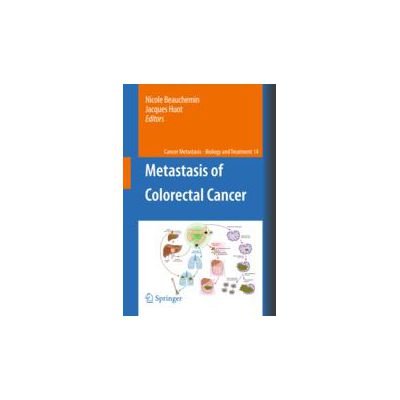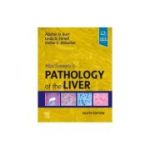Metastasis of Colorectal Cancer

Price: 808,50 lei
Availability: in supplier's stock
Author: Beauchemin, Nicole; Huot, Jacques (Eds.)
ISBN: 978-90-481-8832-1
Publisher: Springer Nature
Publishing Year: 2010
Pages: 416
Category: GASTROENTEROLOGY & HEPATOLOGY
DESCRIPTION
Colorectal cancer is the third most common cancer worldwide, and in many parts of the western world, it is the second leading cause of cancer-related deaths.
This book covers colon cancer metastasis from the most fundamental aspects to clinical practice. Major topics include physiopathology, genetic and epigenetic controls, cancer initiating cells, epithelial-mesenchymal transition, growth factors and signalling, cell adhesion, natures of liver metastasis, angiogenesis and lymphangiogenesis, inflammatory response, prognostic markers, sentinel node and staging, and finally diagnosis and treatment.
Each chapter has been contributed by leaders in the field. A key feature is that it connects with a large readership including students, fundamentalists and clinicians. Another specific feature of the book is that the chapters are written in a didactic and illustrative fashion. These characteristics coupled with the choice of the topics and authors, makes this book a reference in the field. It represents an essential acquisition for medical libraries, clinicians as well as medical and graduate students.
Table of contents
Introduction; N. Beauchemin, J. Huot
1. The Metastatic Process: an Overview; N.Porquet, S. Guot, J. Huot
1.1 Models of metastasis
- 1.1.1 The progression model
- 1.1.2 The transient compartment model
- 1.1.3 The early oncogenesis model
- 1.1.4 The fusion model
- 1.1.5 The gene transfer models
- 1.1.6 The genetic predisposition model
1.2 Metastatic steps
- 1.2.1 Development of the primary colorectal cancer
- 1.2.1.1 Initiation of the primary neoplasm
- 1.2.1.2 Influence of stromal cells
- 1.2.1.3 Influence of the extracellular matrix
- 1.2.1.4 Epithelial-Mesenchymal transition
- 1.2.1.5 Angiogenesis and lymphangiogenesis
- 1.2.2 Intravasation
- 1.2.3 Circulation of cancer cells
- 1.2.4 Extravasation
- 1.2.4.1 The adhesion on endothelial cells and the homing concept of metastasis
- 1.2.4.2 The passage across the endothelium
1.2.5 Colonization of the secondary sites
1.3 Concluding Remarks
References
2. Physiopathology of Colorectal Metastasis; C. Ferrario, M. Basik
2.1 Mechanisms of metastatic spread
- 2.1.1 Circulatory spread
- 2.1.1.1 Lymphatic spread
- 2.1.1.2 Hematogenous spread
- 2.1.2 Local spread
- 2.1.3 Tumour dormancy
2.2 Sites of metastasis and consequences of spread
- 2.2.1 Liver
- 2.2.1.1 Steps in liver invasion
- 2.2.1.2 Development of liver failure
- 2.2.2 Lungs
- 2.2.3 Peritoneum
- 2.2.4 Bone and bone marrow
- 2.2.5 Brain metastasis
2.3 factors contributing to metastatic spread
- 2.3.1 Tumour factors
- 2.3.1.1 Tissue Factor
- 2.3.1.2 EGFR
- 2.3.2 Host factors
- 2.3.2.1 Immunity
- 2.3.2.2 Diet, exercise and liver disease
- 2.3.3 Iatrogenic factors
2.4 Conclusion
References
3. The Genetic of Colorectal Cancer; A.M. Kaz, W.M. Grady
3.1 Introduction
3.2 The Adenoma-to-Carcinoma Sequence
3.3 Genomic Instability
- 3.3.1 Overview
- 3.3.2 Chromosome Instability
- 3.3.3 DNA Mismatch Repair Inactivation and Microsatellite Instability
- 3.3.4 Base Excision Repair Defects/MYH
3.4 Common Deregulated Signalling Pathways
- 3.4.1 Wingless/Wnt Signalling Pathway
- 3.4.1.1 APC
- 3.4.1.2 B-Catenin (CTNNB1)
- 3.4.2 KRAS, BRAF and RAS-RAF-MAPK Signalling Pathway
- 3.4.2.1 K-RAS
- 3.4.2.2 BRAF
- 3.4.3 p53 (TP53)
- 3.4.4 The Phosphatidylinositol 3-kinase (PI3K) Pathway
- 3.4.4.1 PIK3CA
- 3.4.4.2 PTEN
- 3.4.5 TGF-B Signalling Pathways
- 3.4.5.1 TGFBR2
- 3.4.5.2 The SMAD Family of Genes
- 3.4.5.3 TGF-B Superfamily Receptors: ACVR2 and BMPR1A
3.5 Genome-Wide Analyses of Colorectal Cancer Genes
3.6 Metastasis Genes
3.7 Conclusions
References
4. Epigenetics of Colorectal Cancer; F.J. Carmona, M. Esteller
4.1 Introduction
4.2 DNA methylation defects in colorectal cancer
- 4.2.1 Hypomethylation of DNA
4.3 Inactivation of tumour suppressor genes by CpG island hypermethylation
4.4 Epigenetic regulation of microRNA in cancer
4.5 MicroRNAs as metastasis switches
4.6 Histone modification defects in colon cancer
4.7 Epigenetic contribution to colorectal cancer metastasis
4.8 Epigenetic biomarkers and therapies
References
5. Cancer-initiating Cells in Colorectal Cancer; A. Kreso, L. Gibson, C.A. O'Brien
5.1 Introduction
5.2 The cell surface phenotype of colon cancer- initiating cells
5.3 COLON CANCER-INITIATING CELLs and chemoresistance
5.4 The role of CANCER-INITIATING CELLs in metastases
5.5 CANCER-INITIATING CELLs as biomarkers
5.6 CANCER-INITIATING CELLs and clinical trials
5.7 Cell of origin and COLON CANCER-INITIATING CELLs
5.8 Controversies in the cancer stem cell field
5.9 Conclusions
References
6. Epithelial-Mesenchymal Transition in Colorectal Cancer; O. Schmalhofer, S. Brabletz, T. Brabletz
6.1 Introduction
6.2 Tumour budding as a prognostic factor in CRC
6.3 WNT signalling and nuclear B-catenin in CRC
6.4 Intratumoural distribution of nuclear -catenin
6.5 WNT targets in CRC
- 6.5.1 Proliferation-associated WNT targets
- 6.5.2 Stemness-associated WNT targets
- 6.5.3 Invasion- and neo-angiogenesis-associated WNT targets
6.6 Inducers of nuclear B-catenin localization
6.7 Regulation of E-cadherin expression in CRC
6.8 Snail1 and Snail2
6.9 ZEB1, ZEB2 and Twist
6.10 Conclusion
References
7. Cell Adhesion Molecules in Colon Cancer Metastasis; A. Arabzadeh, N. Beauchemin
7.1 Introduction
7.2 Integrins
- 7.2.1 Integrin a-subunits of VLA subfamily; a2, a3, a5 and a6 chains
- 7.2.2 av integrin subfamily
- 7.2.3 Integrin b-subunits; b1, b4 and b6 chains
7.3 E-cadherin
7.4 CD44 and its variant isoforms
7.5 Selectins
751 P-selectin
752 L-selectin
753 E-selectin
7.6 Immunoglobulin (Ig) superfamily
- 7.6.1 Intercellular adhesion molecule-1 (ICAM-1)
- 7.6.2 Carcinoembryonic antigen (CEA)
7.7 Conclusion
References
8. Epithelial Cell Signalling in Colorectal Cancer Metastasis; C. Saucier, N. Rivard
8.1 Receptor tyrosine kinase signalling in colorectal cancer metastases
- 8.1.1 Receptor tyrosine kinase structure and mechanisms of activation
- 8.1.2 Deregulation of receptor tyrosine kinase, a common theme in colon metastases
- 8.1.2.1 EGFR
- 8.1.2.2 Met/HGF receptor
- 8.1.2.3 Receptor tyrosine kinase-targeted therapy
- 8.1.3 The role of RTK-proximal signalling effectors: road maps to the activation of RAS/MAPK and PI3K/AKT
- 8.1.3.1 The role of Grb2, Shc and Gab1 in colorectal cancer, an open question
8.2 The KRAS oncogene and its downstream signalling
- 8.2.1 The ERK MAP kinase signalling pathway
- 8.2.2 The PI3K signalling pathway
- 8.2.3 Oncogenic KRAS signalling inhibits epithelial cell polarity
- 8.2.4 Oncogenic KRAS signalling promotes cell invasion, migration and intravasation
- 8.2.5 Oncogenic KRAS signalling prevents anoikis
- 8.2.6 Oncogenic KRAS signalling in extravasation, proliferation and angiogenesis
8.3 Conclusions
Acknowledgements
References
9. Angiogenesis and Lymphangiogenesis in Colon Cancer Metastasis; D. Garnier, J. Rak
9.1 Introduction: tumour-vascular interface in progression and metastasis of colorectal cancer
9.2 Mechanisms of vascular and lymphatic growth
- 9.2.1 Formation of microvascular networks
- 9.2.2 Lymphangiogenesis and molecular mediators of lymphatic development
9.3 Oncogenic and microenvironmental inducers of tumour angiogenesis in colon cancer
- 9.3.1 Aberrations of the vascular growth in cancer
- 9.3.2 Genesis of the pro-angiogenic phenotype in colorectal cancer
- 9.3.3 Cellular, molecular and systemic triggers of tumour angiogenesis
- 9.3.4 Tumour angiogenesis, metastasis and the haemostatic system
9.4 Effectors of angiogenesis and lymphangiogenesis in primary and metastatic colorectal tumours
- 9.4.1 Angiogenesis in primary CRC
- 9.4.2 Angiogenesis and metastasis in CRC
- 9.4.3 Tumour associated lymphatic circulation in CRC
9.5 Targeting vascular processes in metastatic colorectal cancer
- 9.5.1 Anti-angiogenesis in CRC
- 9.5.2. Anti-lymphangiogenesis
- 9.5.3 Future directions in targeting tumour-vascular interface in metastatic CRC
Acknowledgements
References
10. Role of the Host Inflammatory Response in Colon Carcinoma Initiation, Progression and Liver Metastasis; P. Brodt
10.1 General Introduction
10.2 Role of inflammation in cancer progression: focus on CRC
- 10.2.1 Role of tumour-infiltrating macrophages in tumour progression and in CRC
- 10.2.2 Review of macrophage-derived cytokines that play a role in CRC and liver metastasis
- 10.2.2.1 Role of IL-6
- 10.2.2.2 Role of TNF-a and the TNF receptors
- 10.2.2.3 Role of IL-1
- 10.2.2.4 Role of IL-23
10.3 Role of inflammatory cytokines and chemokines in colon cancer cell invasion and migration.
10.4 Tumour cells entering the liver can elicit a rapid host inflammatory response that promotes metastasis.
- 10.4.1 Pre-extravasation events
- 10.4.2 Post-extravasation events
10.5 Summary and future directions
References
11. Molecular Prognostic Markers in Colon Cancer; T. Winder, H.-J. Lenz
11.1 Introduction
11.2 Pathologic Prognostic Markers
11.3 Genomic Instability
- 11.3.1 Loss of heterozygosity of 17p and 18q (LOH)
- 11.3.2 DNA – Ploidy
- 11.3.3 Microsatellite instability (MSI)
11.4 GENETIC MARKERS
- 11.4.1 Metabolic Genes
- 11.4.1.1 Thymidilate synthase (TS)
- 11.4.1.2 Dihydropyrimidine dehydrogenase (DPD)
- 11.4.1.3 Methylenetetrahydrofolate reductase (MTHFR)
- 11.4.2 EGFR pathway and potential markers
- 11.4.2.1 K-Ras
- 11.4.2.2 B-Raf
- 11.4.2.3 Germline polymorphisms within the EGFR signalling pathway
- 11.4.3 Angiogenesis
- 11.4.3.1 VEGF-dependent regulation of angiogenesis
- 11.4.3.2 VEGF-independent regulation of angiogenesis
11.5 epigenetic markers
- 11.5.1 CpG Island Methylator phenotype (CIMP)
11.6 Ongoing Trials
- 11.6.1 E5202
- 11.6.2 CALGB-C80405
- 11.6.3 PETAC-8
11.7 Conclusions
References
12. The Sentinel Lymph Node and Staging of Colorectal Cancer; G. des Guetz, B. Uzzan
12.1 Introduction
12.2 Feasibility of SENTINEL LYMPH NODE mapping
12.3 Techniques of Sentinel Lymph Node DIAGNOSIS
12.4 Comparaison between SENTINEL LYMPH NODE mapping and standard methods
12.5 Prognostic relevance of occult tumour cells in lymph nodes
12.6 Perspectives
12.7 Conclusion
References
13. Treatment of Colorectal Cancer; E. Al-Sukhni, S. Gallinger
13.1 Surgical Anatomy
13.2 Surgical Options
- 13.2.1 Colon cancer
- 13.2.2 Rectal cancer
13.3 Neo-Adjuvant and Adjuvant Therapy
- 13.3.1 Fluoropyrimidines
- 13.3.2 Oxaliplatin
- 13.3.3 Monoclonal antibodies
- 13.3.4 Other agents
- 13.3.5 Radiotherapy
- 13.3.6 Summary of recommendations for colon cancer
- 13.3.7 Summary of recommendations for rectal cancer
13.4 Surveillance
13.5 Management of Metastatic Disease
- 13.5.1 Resectable metastases
- 13.5.2 Unresectable metastases
- 13.5.3 Resistance to chemotherapy
13.6 Palliative Therapy
13.7 Overall conclusion
References
14. Diagnosis and Treatment of Rectal Cancer; T. Vuong, T. Niazi, S. Liberman, P. Galiatsatos, S. Devic
14.1 Introduction
14.2 Diagnosis and staging of rectal cancer
14.3 The role of radiotherapy in the treatment of rectal cancer
- 14.3.1 External beam radiation therapy in combination with surgery
- 14.3.1.1 Indications
- 14.3.1.2 To prevent local recurrence
- 14.3.1.3 To promote tumour down-staging
- 14.3.1.4 To facilitate sphincter preservation surgery
- 14.3.1.5 To provide local control either with curative or palliative intent
- 14.3.2 Timing of Radiation therapy
- 14.3.3 Radiation therapy alone or with chemotherapy?
- 14.3.4 Dose fractionation
- 14.3.5 Immediate or delayed surgery
14.4 Surgery for Rectal Cancer
- 14.4.1 Laparoscopy
- 14.4.2 Local Treatment for Early Rectal Cancer
14.5 Adjuvant Chemotherapy
- 14.5.1 Before the era of TME surgery
- 14.5.2 Neoadjuvant chemo-radiation therapy and TME era
14.6 Conclusion
References
15. Future Directions; J. Huot, N. Beauchemin
This book covers colon cancer metastasis from the most fundamental aspects to clinical practice. Major topics include physiopathology, genetic and epigenetic controls, cancer initiating cells, epithelial-mesenchymal transition, growth factors and signalling, cell adhesion, natures of liver metastasis, angiogenesis and lymphangiogenesis, inflammatory response, prognostic markers, sentinel node and staging, and finally diagnosis and treatment.
Each chapter has been contributed by leaders in the field. A key feature is that it connects with a large readership including students, fundamentalists and clinicians. Another specific feature of the book is that the chapters are written in a didactic and illustrative fashion. These characteristics coupled with the choice of the topics and authors, makes this book a reference in the field. It represents an essential acquisition for medical libraries, clinicians as well as medical and graduate students.
Table of contents
Introduction; N. Beauchemin, J. Huot
1. The Metastatic Process: an Overview; N.Porquet, S. Guot, J. Huot
1.1 Models of metastasis
- 1.1.1 The progression model
- 1.1.2 The transient compartment model
- 1.1.3 The early oncogenesis model
- 1.1.4 The fusion model
- 1.1.5 The gene transfer models
- 1.1.6 The genetic predisposition model
1.2 Metastatic steps
- 1.2.1 Development of the primary colorectal cancer
- 1.2.1.1 Initiation of the primary neoplasm
- 1.2.1.2 Influence of stromal cells
- 1.2.1.3 Influence of the extracellular matrix
- 1.2.1.4 Epithelial-Mesenchymal transition
- 1.2.1.5 Angiogenesis and lymphangiogenesis
- 1.2.2 Intravasation
- 1.2.3 Circulation of cancer cells
- 1.2.4 Extravasation
- 1.2.4.1 The adhesion on endothelial cells and the homing concept of metastasis
- 1.2.4.2 The passage across the endothelium
1.2.5 Colonization of the secondary sites
1.3 Concluding Remarks
References
2. Physiopathology of Colorectal Metastasis; C. Ferrario, M. Basik
2.1 Mechanisms of metastatic spread
- 2.1.1 Circulatory spread
- 2.1.1.1 Lymphatic spread
- 2.1.1.2 Hematogenous spread
- 2.1.2 Local spread
- 2.1.3 Tumour dormancy
2.2 Sites of metastasis and consequences of spread
- 2.2.1 Liver
- 2.2.1.1 Steps in liver invasion
- 2.2.1.2 Development of liver failure
- 2.2.2 Lungs
- 2.2.3 Peritoneum
- 2.2.4 Bone and bone marrow
- 2.2.5 Brain metastasis
2.3 factors contributing to metastatic spread
- 2.3.1 Tumour factors
- 2.3.1.1 Tissue Factor
- 2.3.1.2 EGFR
- 2.3.2 Host factors
- 2.3.2.1 Immunity
- 2.3.2.2 Diet, exercise and liver disease
- 2.3.3 Iatrogenic factors
2.4 Conclusion
References
3. The Genetic of Colorectal Cancer; A.M. Kaz, W.M. Grady
3.1 Introduction
3.2 The Adenoma-to-Carcinoma Sequence
3.3 Genomic Instability
- 3.3.1 Overview
- 3.3.2 Chromosome Instability
- 3.3.3 DNA Mismatch Repair Inactivation and Microsatellite Instability
- 3.3.4 Base Excision Repair Defects/MYH
3.4 Common Deregulated Signalling Pathways
- 3.4.1 Wingless/Wnt Signalling Pathway
- 3.4.1.1 APC
- 3.4.1.2 B-Catenin (CTNNB1)
- 3.4.2 KRAS, BRAF and RAS-RAF-MAPK Signalling Pathway
- 3.4.2.1 K-RAS
- 3.4.2.2 BRAF
- 3.4.3 p53 (TP53)
- 3.4.4 The Phosphatidylinositol 3-kinase (PI3K) Pathway
- 3.4.4.1 PIK3CA
- 3.4.4.2 PTEN
- 3.4.5 TGF-B Signalling Pathways
- 3.4.5.1 TGFBR2
- 3.4.5.2 The SMAD Family of Genes
- 3.4.5.3 TGF-B Superfamily Receptors: ACVR2 and BMPR1A
3.5 Genome-Wide Analyses of Colorectal Cancer Genes
3.6 Metastasis Genes
3.7 Conclusions
References
4. Epigenetics of Colorectal Cancer; F.J. Carmona, M. Esteller
4.1 Introduction
4.2 DNA methylation defects in colorectal cancer
- 4.2.1 Hypomethylation of DNA
4.3 Inactivation of tumour suppressor genes by CpG island hypermethylation
4.4 Epigenetic regulation of microRNA in cancer
4.5 MicroRNAs as metastasis switches
4.6 Histone modification defects in colon cancer
4.7 Epigenetic contribution to colorectal cancer metastasis
4.8 Epigenetic biomarkers and therapies
References
5. Cancer-initiating Cells in Colorectal Cancer; A. Kreso, L. Gibson, C.A. O'Brien
5.1 Introduction
5.2 The cell surface phenotype of colon cancer- initiating cells
5.3 COLON CANCER-INITIATING CELLs and chemoresistance
5.4 The role of CANCER-INITIATING CELLs in metastases
5.5 CANCER-INITIATING CELLs as biomarkers
5.6 CANCER-INITIATING CELLs and clinical trials
5.7 Cell of origin and COLON CANCER-INITIATING CELLs
5.8 Controversies in the cancer stem cell field
5.9 Conclusions
References
6. Epithelial-Mesenchymal Transition in Colorectal Cancer; O. Schmalhofer, S. Brabletz, T. Brabletz
6.1 Introduction
6.2 Tumour budding as a prognostic factor in CRC
6.3 WNT signalling and nuclear B-catenin in CRC
6.4 Intratumoural distribution of nuclear -catenin
6.5 WNT targets in CRC
- 6.5.1 Proliferation-associated WNT targets
- 6.5.2 Stemness-associated WNT targets
- 6.5.3 Invasion- and neo-angiogenesis-associated WNT targets
6.6 Inducers of nuclear B-catenin localization
6.7 Regulation of E-cadherin expression in CRC
6.8 Snail1 and Snail2
6.9 ZEB1, ZEB2 and Twist
6.10 Conclusion
References
7. Cell Adhesion Molecules in Colon Cancer Metastasis; A. Arabzadeh, N. Beauchemin
7.1 Introduction
7.2 Integrins
- 7.2.1 Integrin a-subunits of VLA subfamily; a2, a3, a5 and a6 chains
- 7.2.2 av integrin subfamily
- 7.2.3 Integrin b-subunits; b1, b4 and b6 chains
7.3 E-cadherin
7.4 CD44 and its variant isoforms
7.5 Selectins
751 P-selectin
752 L-selectin
753 E-selectin
7.6 Immunoglobulin (Ig) superfamily
- 7.6.1 Intercellular adhesion molecule-1 (ICAM-1)
- 7.6.2 Carcinoembryonic antigen (CEA)
7.7 Conclusion
References
8. Epithelial Cell Signalling in Colorectal Cancer Metastasis; C. Saucier, N. Rivard
8.1 Receptor tyrosine kinase signalling in colorectal cancer metastases
- 8.1.1 Receptor tyrosine kinase structure and mechanisms of activation
- 8.1.2 Deregulation of receptor tyrosine kinase, a common theme in colon metastases
- 8.1.2.1 EGFR
- 8.1.2.2 Met/HGF receptor
- 8.1.2.3 Receptor tyrosine kinase-targeted therapy
- 8.1.3 The role of RTK-proximal signalling effectors: road maps to the activation of RAS/MAPK and PI3K/AKT
- 8.1.3.1 The role of Grb2, Shc and Gab1 in colorectal cancer, an open question
8.2 The KRAS oncogene and its downstream signalling
- 8.2.1 The ERK MAP kinase signalling pathway
- 8.2.2 The PI3K signalling pathway
- 8.2.3 Oncogenic KRAS signalling inhibits epithelial cell polarity
- 8.2.4 Oncogenic KRAS signalling promotes cell invasion, migration and intravasation
- 8.2.5 Oncogenic KRAS signalling prevents anoikis
- 8.2.6 Oncogenic KRAS signalling in extravasation, proliferation and angiogenesis
8.3 Conclusions
Acknowledgements
References
9. Angiogenesis and Lymphangiogenesis in Colon Cancer Metastasis; D. Garnier, J. Rak
9.1 Introduction: tumour-vascular interface in progression and metastasis of colorectal cancer
9.2 Mechanisms of vascular and lymphatic growth
- 9.2.1 Formation of microvascular networks
- 9.2.2 Lymphangiogenesis and molecular mediators of lymphatic development
9.3 Oncogenic and microenvironmental inducers of tumour angiogenesis in colon cancer
- 9.3.1 Aberrations of the vascular growth in cancer
- 9.3.2 Genesis of the pro-angiogenic phenotype in colorectal cancer
- 9.3.3 Cellular, molecular and systemic triggers of tumour angiogenesis
- 9.3.4 Tumour angiogenesis, metastasis and the haemostatic system
9.4 Effectors of angiogenesis and lymphangiogenesis in primary and metastatic colorectal tumours
- 9.4.1 Angiogenesis in primary CRC
- 9.4.2 Angiogenesis and metastasis in CRC
- 9.4.3 Tumour associated lymphatic circulation in CRC
9.5 Targeting vascular processes in metastatic colorectal cancer
- 9.5.1 Anti-angiogenesis in CRC
- 9.5.2. Anti-lymphangiogenesis
- 9.5.3 Future directions in targeting tumour-vascular interface in metastatic CRC
Acknowledgements
References
10. Role of the Host Inflammatory Response in Colon Carcinoma Initiation, Progression and Liver Metastasis; P. Brodt
10.1 General Introduction
10.2 Role of inflammation in cancer progression: focus on CRC
- 10.2.1 Role of tumour-infiltrating macrophages in tumour progression and in CRC
- 10.2.2 Review of macrophage-derived cytokines that play a role in CRC and liver metastasis
- 10.2.2.1 Role of IL-6
- 10.2.2.2 Role of TNF-a and the TNF receptors
- 10.2.2.3 Role of IL-1
- 10.2.2.4 Role of IL-23
10.3 Role of inflammatory cytokines and chemokines in colon cancer cell invasion and migration.
10.4 Tumour cells entering the liver can elicit a rapid host inflammatory response that promotes metastasis.
- 10.4.1 Pre-extravasation events
- 10.4.2 Post-extravasation events
10.5 Summary and future directions
References
11. Molecular Prognostic Markers in Colon Cancer; T. Winder, H.-J. Lenz
11.1 Introduction
11.2 Pathologic Prognostic Markers
11.3 Genomic Instability
- 11.3.1 Loss of heterozygosity of 17p and 18q (LOH)
- 11.3.2 DNA – Ploidy
- 11.3.3 Microsatellite instability (MSI)
11.4 GENETIC MARKERS
- 11.4.1 Metabolic Genes
- 11.4.1.1 Thymidilate synthase (TS)
- 11.4.1.2 Dihydropyrimidine dehydrogenase (DPD)
- 11.4.1.3 Methylenetetrahydrofolate reductase (MTHFR)
- 11.4.2 EGFR pathway and potential markers
- 11.4.2.1 K-Ras
- 11.4.2.2 B-Raf
- 11.4.2.3 Germline polymorphisms within the EGFR signalling pathway
- 11.4.3 Angiogenesis
- 11.4.3.1 VEGF-dependent regulation of angiogenesis
- 11.4.3.2 VEGF-independent regulation of angiogenesis
11.5 epigenetic markers
- 11.5.1 CpG Island Methylator phenotype (CIMP)
11.6 Ongoing Trials
- 11.6.1 E5202
- 11.6.2 CALGB-C80405
- 11.6.3 PETAC-8
11.7 Conclusions
References
12. The Sentinel Lymph Node and Staging of Colorectal Cancer; G. des Guetz, B. Uzzan
12.1 Introduction
12.2 Feasibility of SENTINEL LYMPH NODE mapping
12.3 Techniques of Sentinel Lymph Node DIAGNOSIS
12.4 Comparaison between SENTINEL LYMPH NODE mapping and standard methods
12.5 Prognostic relevance of occult tumour cells in lymph nodes
12.6 Perspectives
12.7 Conclusion
References
13. Treatment of Colorectal Cancer; E. Al-Sukhni, S. Gallinger
13.1 Surgical Anatomy
13.2 Surgical Options
- 13.2.1 Colon cancer
- 13.2.2 Rectal cancer
13.3 Neo-Adjuvant and Adjuvant Therapy
- 13.3.1 Fluoropyrimidines
- 13.3.2 Oxaliplatin
- 13.3.3 Monoclonal antibodies
- 13.3.4 Other agents
- 13.3.5 Radiotherapy
- 13.3.6 Summary of recommendations for colon cancer
- 13.3.7 Summary of recommendations for rectal cancer
13.4 Surveillance
13.5 Management of Metastatic Disease
- 13.5.1 Resectable metastases
- 13.5.2 Unresectable metastases
- 13.5.3 Resistance to chemotherapy
13.6 Palliative Therapy
13.7 Overall conclusion
References
14. Diagnosis and Treatment of Rectal Cancer; T. Vuong, T. Niazi, S. Liberman, P. Galiatsatos, S. Devic
14.1 Introduction
14.2 Diagnosis and staging of rectal cancer
14.3 The role of radiotherapy in the treatment of rectal cancer
- 14.3.1 External beam radiation therapy in combination with surgery
- 14.3.1.1 Indications
- 14.3.1.2 To prevent local recurrence
- 14.3.1.3 To promote tumour down-staging
- 14.3.1.4 To facilitate sphincter preservation surgery
- 14.3.1.5 To provide local control either with curative or palliative intent
- 14.3.2 Timing of Radiation therapy
- 14.3.3 Radiation therapy alone or with chemotherapy?
- 14.3.4 Dose fractionation
- 14.3.5 Immediate or delayed surgery
14.4 Surgery for Rectal Cancer
- 14.4.1 Laparoscopy
- 14.4.2 Local Treatment for Early Rectal Cancer
14.5 Adjuvant Chemotherapy
- 14.5.1 Before the era of TME surgery
- 14.5.2 Neoadjuvant chemo-radiation therapy and TME era
14.6 Conclusion
References
15. Future Directions; J. Huot, N. Beauchemin
Book categories
-Special order
-Publishers
-Promo
-Callisto Publications
-New books
-- 1680,00 leiMRP: 1837,50 lei
- 105,00 lei
- 147,00 lei
Promotions
-- 2409,75 leiMRP: 2835,00 lei
- 1512,00 leiMRP: 1680,00 lei
- 1191,96 leiMRP: 1365,00 lei












OUR VISITORS OPINIONS